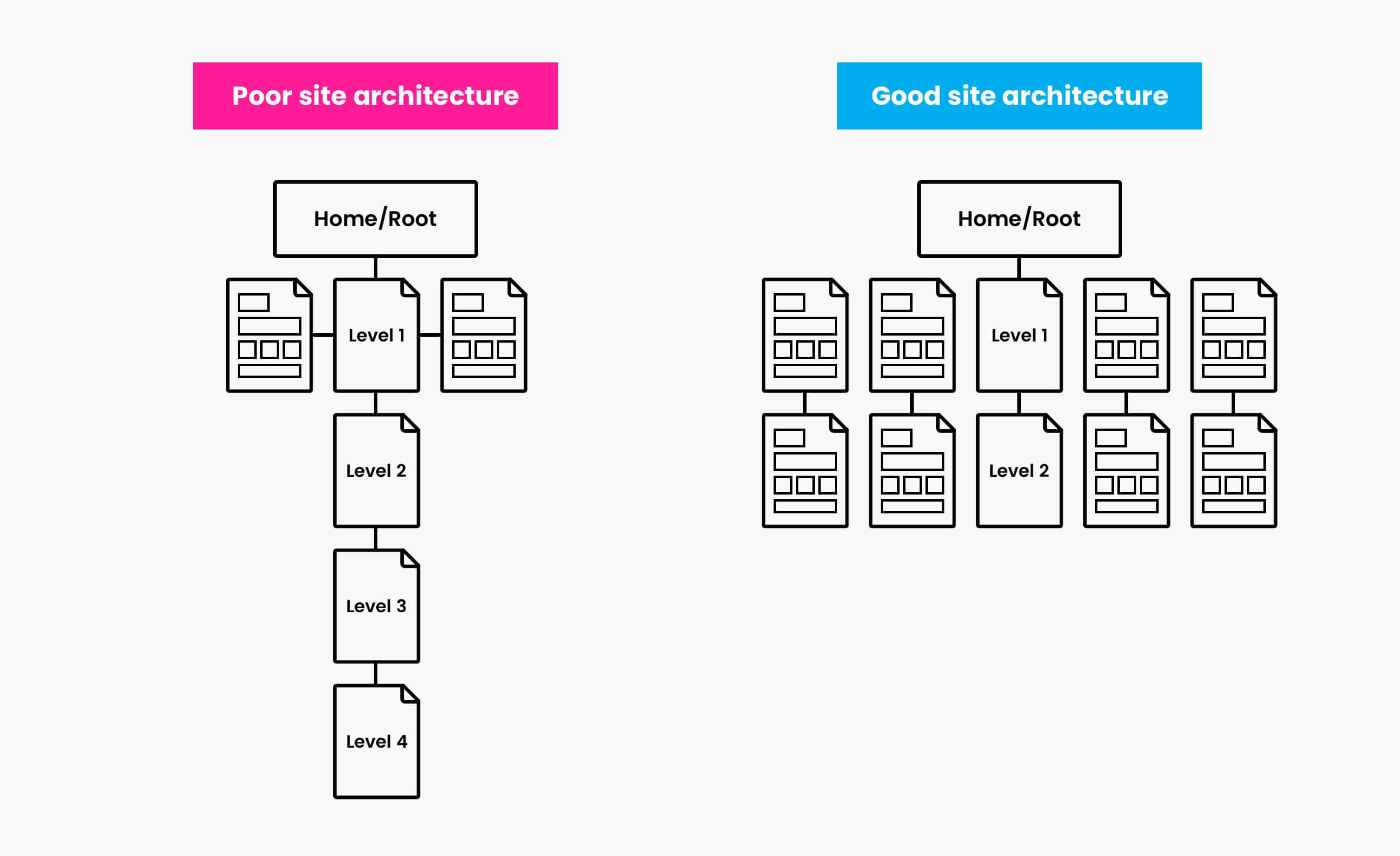Read on to find examples of common SEO mistakes which might be affecting your business performance, alongside useful advice on how to identify and fix these issues.
Reliance on Branded Traffic
Not sure what counts as “branded” traffic”? Simple: it’s the traffic which arrives at your website after using a search engine with your company name included in the query or keyword.
Use Selesti as an example. ‘Selesti search marketing’ would be a branded term, while ‘search marketing company’ would be categorised as ‘non-brand’ or ‘generic’.
So, both Google and its users are aware of your company’s name and using it to find you—what’s the problem here? Well, if the vast majority of your traffic arrives this way, it may mean that your site isn’t being found for non-brand terms. This can be a big issue.
By not being visible to new customers who haven’t yet heard of you, you could be limiting your growth to new audiences, for instance. It’s also important to be aware of how much customer expectations are changing in this age of digital and technological disruption.

Resting on your laurels, expecting that your high-profile brand will guarantee results, can be a big mistake. This is proven by the rise of disruptive companies and the decline of high street brands which failed to embrace their changing audience.
Grow your non-brand traffic by understanding your users
Firstly, identify what potential customers—who aren’t yet aware of your solution—are searching for.
Your customers use the internet to find new information all the time. If your competitors are providing the information they need, you could be losing out. To get started, you can research forums and community websites to discover the issues your customers are talking about.
You can also use various tools to get an idea of what customers need help with. Platforms such as answerthepublic and Soovle can be invaluable in this regard, helping you understand how users search for things during different stages of their journey.
Help your customers solve their problems
You’ve identified the most in-demand questions and concerns from would-be customers. Now you can create content and resources which addresses these customers specifically.

Customer loyalty is not easily won, but providing useful assets is a big step towards making the customer feel you’re on their side. You can create what we call “evergreen” content—articles or resources which will stay relevant for a long time. So that they never become obsolete, this content can be updated with new information as it comes out.
You can also help to protect your brand against increasing competition by finding ways to offer convenient digital experiences that quickly solve customer problems.
IN SHORT: Find out if you’re relying too much on brand recognition. Then plan how to be as visible and helpful to new and potential customers as possible.
Focus on Mobile-first
We all know that the mobile phone is now the primary device for most internet users. But are we taking mobile seriously enough, in a mobile-first world?
Without consideration for mobile audiences, your Google rankings can decline. In fact, you might have already seen a decrease in sitewide traffic since Google enabled “mobile-first” indexation for your site. Maybe it’s the opposite—your mobile traffic has shot up, but engagement and conversions for mobile users could be way down compared to desktop?
Without focusing on mobile user experience, you could be preventing sales and other conversions. Worse still: if your mobile UX has been neglected, you could be alienating a segment of your audience who may write you off based on first impressions.
Consider the desktop vs mobile experience
Consumers now tend to expect a fully featured experience, even on mobile. Similarly, Google’s crawlers will index your website based on how it looks and acts for mobile users. Understanding this should put you in the right frame of mind to approach your website’s structure and functionality.

You should ask yourself: can you do everything on the mobile site as you can on desktop? Is the content on the mobile and desktop site identical? If so, is the mobile version as easy to use?
Thoroughly test the mobile journey
Someone in your organisation should be testing the main user journeys on your site, using a smartphone.
You’d be surprised how many issues can be discovered through a process of manual quality assurance. Only by thoroughly checking every element of the site can you ensure users are able to complete the main activities they’d want to.
But know that internal testing is sometimes not enough. It’s always good to perform some tests using people who are unfamiliar with your website. This way, you can establish a true understanding of your site’s usability without any prior knowledge. User testing platforms like Usertesting.com, effectively a digital equivalent to a focus group, offer a cost-effective route to accomplishing this.
Select a champion for your mobile users
Who in your organisation is taking ownership of the mobile audience, and identifying how they use the site?
With vast amounts of data providing information on your mobile users’ behaviour, you could find the clues you need to meet their needs. Now is the perfect moment to take a ‘mobile-first’ approach to your digital strategy. This is how we’ve been approaching UX at Selesti for some time—ensuring the mobile user is placed at the centre of planning and execution of new site builds.
IN SHORT: Don’t neglect your mobile audience, or it could be too late. Investigate the growth of this segment and what you can do to innovate and meet their unique needs.
Website structure
Your digital success may be limited if your site isn’t structured the right way for both search engines and customers.
You can identify this issue a number of ways.
Perhaps users are reaching your site’s home page, but not finding their way to key products and services. Users may not have the opportunity to find the content you want them to see, or they struggle to get where they want to go. This is possibly due to the site being built without careful consideration of the average user’s journey. Maybe the site is hard to navigate—a surprisingly common issue when a website’s designers prioritise form over function.

Perhaps your website’s traffic is unbalanced, with the vast majority arriving through only one or two pages! Content can be a highly valuable asset, but if that content isn’t appearing in organic search results, its value is severely diminished. This is usually because Googlebot can’t do its job by crawling and indexing your site.
There are many important elements in site structure: from page depth and duplication to topical clustering and the hierarchy of subdirectories used in URLs. If these fundamentals aren’t set up for search engine robots, your visibility in organic search results will always be limited. That also means your marketing budget is being allocated without guarantee of return.
Enforce effective website structure with content
A common method for establishing good site structure is to employ a ‘content clusters’ approach.
This describes best practice guidance for organising your content around topics and themes. Using this approach should help Google understand how your content links together. It should also benefit your rankings. Find more detail in our blog post on the subject.

Seek a technical SEO audit
If your content isn’t being read and indexed by Google or seen by your customers, be curious. Why is that?
An SEO audit will flag significant issues preventing your site from appearing for the users who are looking for you. Are any important pages and assets on your website accidentally blocked? Or is your poor return-on-investment from content creation due to “orphaned” pages, buried by a lack of internal links?

Common issues explored by a technical audit might include your HTTPS implementation, your Sitemap, the distribution and crawlability of your content. These, and dozens of key factors that Google’s robots are considering when analysing your site.
There really are too many things to cover in this blog. However, a technical SEO audit could be the most effective way to unearth the issues which are limiting your potential.
IN SHORT: If your content isn’t having the desired impact or bringing in the traffic, consider seeking an SEO audit or UX analysis to uncover where your site’s structure could be limiting your potential.
Uniting your offline and online presence
If you’re still treating your physical store and digital presence as separate silos, you’re likely missing major opportunities to boost the results you get from both.
One issue with treating offline and online separately, is that you’re missing out on the increased real estate available in search results pages. Approximately 43% of searches have a local search intent and, as a result, Google gives a lot of prominence to features such as map results.
By emphasising your local presence online, you can clearly signpost your locality to Google, who will serve your site to local users as a consequence.
So, how do you maximise your local search visibility by using your offline assets?
Map customer journeys to online and offline touchpoints
There are new opportunities to track your users across their mobile and desktop devices as they interact with your company. New tracking capabilities such as Google Beacons can also allow you to connect your data to physical visits to your store. With this information, you can learn about which content suits customers, at exactly which time. By customising your promotional materials to specific stages of the user journey, you can ensure customers are greeted with the messaging which is more likely to encourage a purchase.
Connect and reinforce both online and offline experiences
The unification of your offline and online assets is an opportunity to have both reinforce the other.
Start brainstorming ways your online and offline assets can work together. There could be promotions in your store that online users, searching for your company locally, aren’t being made aware of. There could be loyal customers in your stores who aren’t given reason to visit the website.

Yet there’s so much room for innovation here that it’s considered to be one of the ‘hot topics’ of this year, with a rising emphasis on part-digitised ‘in-store experiences’.
Have a look into what brands such as Tiffany & Co, Made.com, STORY—as well as ‘New Retail’ brands in China such as Hema—are doing. These companies are transforming physical stores into experiential assets, integrating digital processes and promotions into their shopfronts.
Emphasise local search signals on your website
It’s a good time to shout about your locality, as Google will likely reward you with local rankings.
Make sure all of the information on your website and Google My Business account is accurate. Include your address and Google map on your local website. Use a Google Beacon, if you have one. And ensure you’re creating content for offline conversions!

IN SHORT: Take opportunities to look at your physical store as an asset in your digital projects. Signal your locality online as much as possible, and use both sides of the business to boost the results of campaigns across the board.
Do you want a helping hand with investigating and solving the SEO issues affecting your performance? Get in touch with our team, specialists in technical consultancy and ongoing SEO services.


